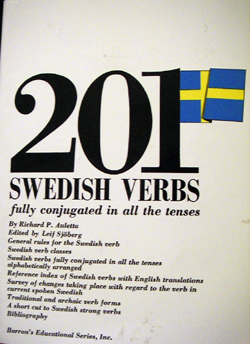201 Swedish Verbs Posted by Transparent Language on Jan 3, 2009 in Grammar
 Do you like learning about verbs? I mean, learning foreign verbs? If you’re like me, you probably love it and detest it, depending on the weather.
Do you like learning about verbs? I mean, learning foreign verbs? If you’re like me, you probably love it and detest it, depending on the weather.
Someone asked me not so long ago about a good book when it comes to mastering Swedish verbs. And I think I mentioned “201 Swedish Verbs (fully conjugated in all the tenses)” but honestly, I don’t know what on earth I was thinking.
“201 Swedish Verbs (fully conjugated in all the tenses)” by Richard Auletta and Leif Sjöberg, ISBN 0-8120-0528-7
I have this book. And let me tell you, as far as verb books go, this one is well, how to put it nicely… I guess “mediocre” will have to do.
The concept is great. I’ve used books from this series (Barron’s Educational Series) for learning Spanish and French. I liked how they explained everything in excruciating detail, and how the verbs were presented in all the tenses and forms and what not. It was designed for dummies like me. It was just perfect.
But the “201 Swedish Verbs” book is far from perfect. Why? Oh, let me count the ways!
- 1. Swedish verbs stay the same regardless of which subject pronoun you use, whether it is jag, du, han, hon, vi, ni or de, the verb form stays the same.
Yet, all the forms with their applicable pronouns are listed on every page
- 2. Just like in English, some Swedish verbs are irregular. But many are perfectly regular, and after you’ve seen a couple of them, you can follow the pattern in your sleep.Yet, such perfectly regular verbs as “arbeta” (to work) and “baka” (to bake) and “börja” (to begin) and many, many others are included in the book.
- 3. Some Swedish verbs are very similar to the ones in English. So similar in fact, that you have absolutely no doubt regarding their meaning.Yet such verbs are also included in this book: “kritisera” (to criticize) and “öppna” (to open) for example. And wouldn’t you know it? It’s a regular verb, too!
- 4. Most foreign language learners are interested mainly in irregular verbs, right? Those are the ones that give students the most trouble.
So why not make a book chock-full of irregular verbs instead?
- 5. The book was first published in 1975. It claims to include all the verbs which occur in the three thousand words in Swedish. Well, that might have been the case in 1975, but really, who in this day and age uses the word “to curtsy” (niga)?
In the authors defense, it IS an irregular verb, though it’s far from a common one these days.
The book is in a desperate need of an update, that much is clear.
Yet, if you are struggling with Swedish verbs, this might be a helpful choice.

Build vocabulary, practice pronunciation, and more with Transparent Language Online. Available anytime, anywhere, on any device.




Comments:
Peter Miller:
Hej Anna
I bought this book and it didn’t have the 202nd verb that I was always looking for.
For you grammar junkies, I found this website helpful
http://sv.wiktionary.org/wiki/Wiktionary:Huvudsida
It has nouns, verbs, adjectives along with examples.
Try it!!
Sean Schneider:
I have a copy of 201 Verbs and I would go further than mediocre, it’s rubbish.
There is a newish book available which has loads more verbs and helpful bits on conjugation and even includes modern slang.
http://www.geocities.com/davidghensleigh/engcsv.htm
Jag bör säga att det är kul att höra alla idiosynkrasierna från ditt liv i Sverige! Det är jättehjälpsamt till oss som vill förstår svenskarna bättre.
Brandon Gustafson:
I own/love this book!
jayden:
Anna,
I find your criticism to be rather harsh and also incomplete. You mention all the bad points about the book (most of those points really only count as one – lack of common irregular verbs) but neglect the better points.
I myself happen to love this book. If you actually bothered to read the first 50 pages or so, you would find it actually gives a very very concise and clear explanation of how Swedish verbs work, not only in modern Swedish, but how they came to be like that.
Anyone seriously wanting to learn Swedish should be able to read through the first 50 pages and be able to recognise the forms required to take. It even gives a very detailed diagram of the ablaut patterns in strong (or as you call them, irregular) verbs which are not as irregular as you think, but more so belonging to a different class of verbs with more complicated rules than your “regular” verbs.
As it mentions in the book, the list isn’t exhaustive, and the book was never meant as a dictionary or a conjugation lookup. I think the intended reasons for the lists was more or less to provide examples to each of the rules and conjugal techniques mentioned in the first 50 pages, as it does very well so giving a good range of examples. (Yes this means it has a lot of regular verbs too, with 4 verb classes that gives at least 50 verbs per class, so get over it).
For a $10 buy (give or take) this book is invaluable for anyone SERIOUS about studying Swedish, and not for the casual tourist wanting to communicate roughly and quickly.
Jayden